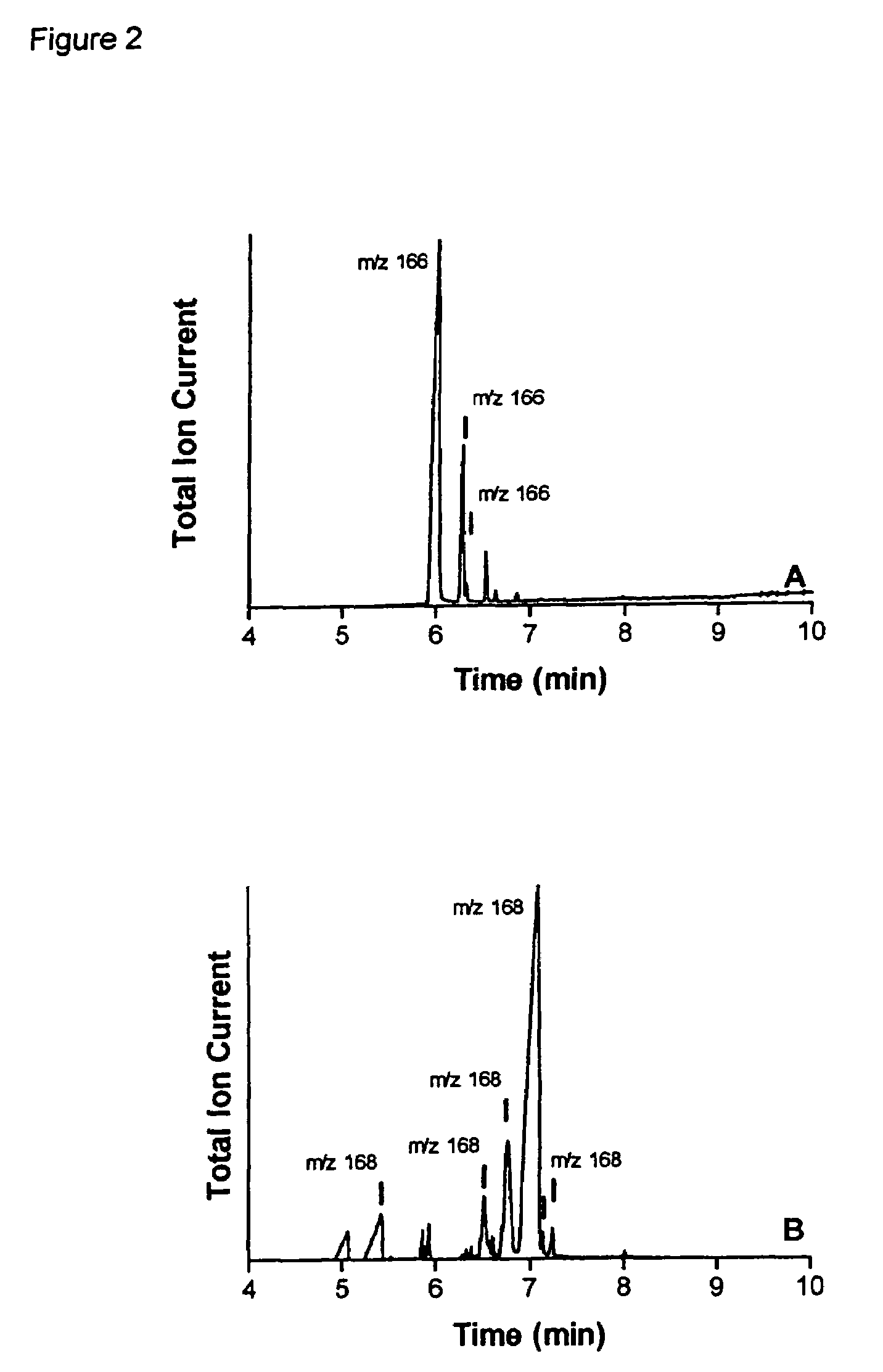Insect repellent compounds
a technology of insect repellent and compound, which is applied in the field of insect repellent, can solve the problems of unattractive or offensive insect food sources or living conditions, possesses unpleasant odor, and greasy skin, and achieves the effect of augmenting or enhancing the insect repellent effect of an articl
- Summary
- Abstract
- Description
- Claims
- Application Information
AI Technical Summary
Benefits of technology
Problems solved by technology
Method used
Image
Examples
example 1
Preparation of Nepetalactones by Fractional Steam Distillation of Oil of Nepeta cataria
[0093]A sample of commercially-available catnip oil, prepared by steam distillation of herbaceous material from the catmint Nepeta cataria, was obtained (Berjé, Bloomfield, N.J., USA). Combined gas chromatography—mass spectrometry (GC-MS) of this oil indicated that the principal constituents were nepetalactone stereoisomers (data not shown).
[0094]The nepetalactone fraction was further purified by fractional distillation of this oil. FIG. 2A presents the GC-MS total ion chromatogram of the nepetalactone-enriched fraction prepared by fractional distillation of the commercial sample of Nepeta cataria essential oil. The conditions employed were: column HP5-MS, 25 m×0.2 mm; oven 120° C., 2 min, 15° C. / min, 210° C., 5 min.; He@ 1 ml / min. Peaks with m / z 166 are nepetalactones). The unlabelled peaks correspond to minor sesquiterpenoid contaminants. In FIG. 3A, the mass spectrum of the major peak (6.03 mi...
example 2
Preparation of Dihydronepetalactones
[0097]107 g of the distilled nepetalactone fraction of the catmint oil prepared as described in Example 1 was dissolved in ethanol (200 ml) and placed in a Fisher-Porter bottle with 12.7 g 2% Pd / SrCO3 (Aldrich 41,461-1). The tube was evacuated and backfilled with H2 two times, then charged with H2 at 30 psig. After 48 hr stirring at room temperature, the tube was vented and the contents filtered over Celite to remove catalyst. The solvent was removed under vacuum, yielding a clear oil.
[0098]GC-MS analysis (column HP5-MS, 25 m×0.2 mm; Oven 120° C., 2 min, 15° C. / min, 210° C., 5 min.; He@ 1 ml / min) was conducted on this material. The total ion chromatogram is presented in FIG. 2B. This analysis indicated that the principal component (65.43% area; Rt 7.08 min) represented a dihydronepetalactone isomer, with m / z 168; the mass spectrum of this component is presented in FIG. 3B. This spectrum contains an ion with m / z 113, diagnostic for dihydronepetalac...
example 3
Repellency Testing of a Dihydronepetalactone Mixture
[0106]The dihydronepetalactone mixture prepared in accordance with Example 2 was evaluated for its repellent effects against female Aedes aegypti mosquitoes. These tests were carried out under contract by Insect Control & Research, Inc. (Baltimore, Md.).
[0107]Approximately 250 female Aedes aegypti mosquitoes were introduced into a chamber containing 5 wells, each covered by a Baudruche membrane. Wells were filled with bovine blood, containing sodium citrate (to prevent clotting) and ATP (72 mg ATP disodium salt per 26 ml of blood), and heated to 37° C. A volume of 25 μl of isopropyl alcohol, containing putative repellent chemicals (Table 2), was applied to each membrane.
[0108]
TABLE 2Experimental Design Applied for Repellency TestingPurposeCompoundConcentrationUntreated ControlIsopropyl alcohol 100%Positive ControlIsopropyl alcohol with DEET 1.0% (w / v)Experimental SamplesIsopropyl alcohol with 1.0% (w / v)Dihydronepetalactone 2.5% (w / ...
PUM
 Login to View More
Login to View More Abstract
Description
Claims
Application Information
 Login to View More
Login to View More - R&D
- Intellectual Property
- Life Sciences
- Materials
- Tech Scout
- Unparalleled Data Quality
- Higher Quality Content
- 60% Fewer Hallucinations
Browse by: Latest US Patents, China's latest patents, Technical Efficacy Thesaurus, Application Domain, Technology Topic, Popular Technical Reports.
© 2025 PatSnap. All rights reserved.Legal|Privacy policy|Modern Slavery Act Transparency Statement|Sitemap|About US| Contact US: help@patsnap.com



